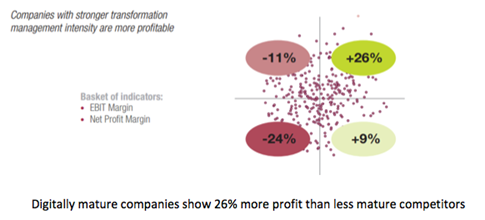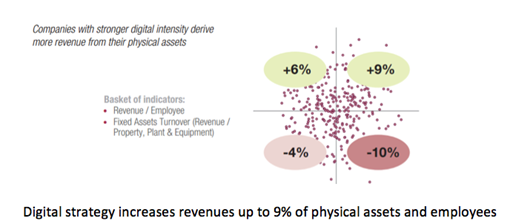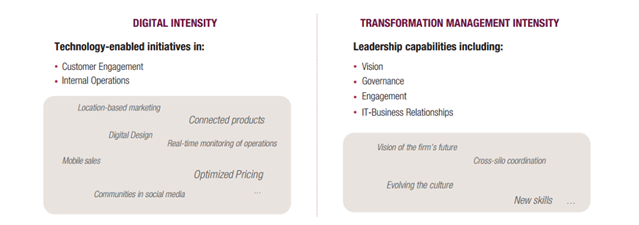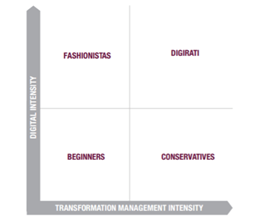What’s clear in most industry sectors is this; you need to have a digital strategy or your business will eventually be in trouble.
Digital Strategy Comes First
The trend of digital transformation is really a mission to create more profitable and sustainable companies. We believe the way to do that is to create a strategy that embraces customer-centric thinking and marry that with your business goals. Because in the end of the day, the customer wants your product or service and our job is the create the means for discovery and the delightful experience that will enhance the opportunity for that transaction and ongoing relationship.
The explosion of social media, mobile devices and digital technologies has created a class of highly advanced, choice-conscious consumers and the means to target, understand and personalize for their interests. This win-win relationship of needs and gratification, when optimally implemented, increases conversions to paying customers, generates greater revenues for the organization and ultimately, increases company valuations - as long as you map out a winning strategy.
Profitability and Digital Maturity
The goal of any business is to be profitable. A study by MIT Sloan/Cap Gemini shows that the degree an organization has a developed a coherent and viable digital strategy, is directly related to revenue generation and company valuation. The companies in the most advance 26% more than the least digitally mature competitors, as shown in the diagram below

It is interesting to note that digital customer engagement also drives more traffic and revenue through an organizations physical assets. Which bears mentioning particularly as mobile devices are used in location discovery in as much as 40% of in-store purchases, for instance. Or said another way, customers use their devices to find what they are looking for.
In many cases, purchases are either made through the device and picked up at a store, or the customer will find the store that is most suitable and make the purchase in person.
This is why having an omnichannel, customer-centric strategy is so important. This is one way a company’s total physical assets are better monetized through digital maturity.

It also makes sense that a company is rewarded with a higher valuation if having an evolved digital presence and workforce is generating increased revenues and profits. An organization that is digitally transformed from the inside out, with the CEO, management team and key positions “speaking digital”, is a company positioned to remain a leader in their category.

It’s the Digital Advantage that Makes the Difference
What’s clear in most industry sectors is this; you need to have a digital strategy or your business might be in trouble. Maybe not today or tomorrow, but soon enough. Resisting is futile, the age of digital empowerment and social media can either liberate you and bring new opportunities, or it will slice into your revenues significantly because one of your competitors or a disruptor has figured it out before you – or for you.
Your digital strategy assumes that you will be facing both technologically sophisticated consumers and those who simply use their devices casually. In either case, the more you can engage and satisfy the needs of your customers online, the more efficient you can make your company.
Digital also encompasses the wide array big data and analytics, social media platforms, embedded devices and self-service platforms that can create a positive impact on business models, internal operations and the bottom line. Pure play tech firms like Google, Pinterest, Uber,Apple stand testament to this fact, but this also applies to bricks and mortar companies like Sephora, Catepillar, Lowes and Macy’s, who have turned to digital to stay current, grow and develop alternative business models.
Digital Maturity Leads to Market Performance

Digital maturity is a much talked about classification. As a note, we believe that most well established organizations face much more opportunity than threat when it comes to digital, today. A few years from now that will certainly be the opposite for those companies that have not adequately prepared themselves. We will use the MIT/Cap Gemini definition for maturity, that breaks down the organization by the initiatives they’ve undertaken and the internal change they have implemented.
- Digital Intensity – These businesses are focused on technological enablement and usually launch and fund initiatives that are focused on improving internal operations, customer engagement and improved commerce. Burberry is an excellent example of a digitally intensive company that has managed change and updated their brand to great success.
- Transformation Management Intensity – These businesses are dedicated on crafting leadership capabilities that are focused on triggering digital transformations within the organization. They have undergone a process of remodeling the company vision, engagement, talent recruitment, governance, IT business management and much Volvo and Nike are examples of companies that have committed to transforming management.
Rating Your Digital Maturity
Figuring out your digital maturity relates to the degree of your internal management transformation and your digital presence in the market. Again, there are any number of competing explanations, calculations and nomenclatures for this, but as a rule of thumb, these categories are a quick and simple way to evaluate yourself and your competitors. This is how MIT/Cap Gemini break it down. Why should you do this? The more mature your organization is, the more revenues it will generate and more value is created:
- Beginners – Companies that are just starting out or beginning to explore their options in digital media. They might be unaware of all the options available to them.
- Conservatives – This group consists of businesses that favor the old way of doing things and are not eager to innovat Moderation is key and they prefer to play it safe. No risk, no reward.
- Fashionistas – This group consists of businesses that like using digital media to look good. There may not always be a practical benefit behind their digital applications, which leads to a hit and miss approach rather than a measured and carefully crafted strategy.
- Digirati – The truly developed and digitally mature businesses are termed as the Digirati. They not only understand the value but are also able to drive digital transformation. These are the ones who can truly predict and cultivate digital change to their advantage.

Your business will fall somewhere near one of these groups.
Our own Digital Opportunities Survey has been created to highlight just that, your opportunities - and is less concerned with placing you into a constructed category. Markets change fast and frequently, moving the digital goal post all the time.
Today you can have no digital strategy or means to create a product and tomorrow you can jump into the fray with an innovative business model that catapults you to the front of the line and drags the rest of company along into the new world of digitally mature companies.
You can take our Digital Opportunity Survey Here and find out how we can help you transform now.



